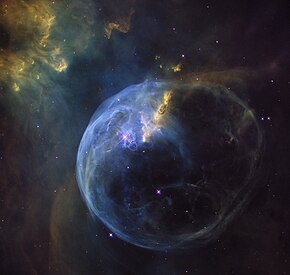Bubble Nebula: Difference between revisions
UnaToFiAN-1 (talk | contribs) →External links: +{{Cassiopeia (constellation)}} |
Sacredsouth (talk | contribs) removed repetitive images |
||
| Line 18: | Line 18: | ||
| names = Bubble Nebula{{sfn|SIMBAD|2007}}<br />[[Sharpless catalog|Sharpless]] 162 (Sh2-162)<br />[[Caldwell catalogue|Caldwell]] 11 |
| names = Bubble Nebula{{sfn|SIMBAD|2007}}<br />[[Sharpless catalog|Sharpless]] 162 (Sh2-162)<br />[[Caldwell catalogue|Caldwell]] 11 |
||
}} |
}} |
||
'''NGC 7635''', also known as the '''Bubble Nebula''', '''Sharpless 162''', or '''Caldwell 11''', is an [[H II region|H II region |
'''NGC 7635''', also known as the '''Bubble Nebula''', '''Sharpless 162''', or '''Caldwell 11''', is an [[H II region|H II region]] in the constellation [[Cassiopeia (constellation)|Cassiopeia]].{{sfn|SIMBAD|2007}} It lies close to the direction of the [[open cluster]] [[Messier 52]]. The "bubble" is created by the [[stellar wind]] from a massive hot, 8.7{{sfn|SIMBAD|2007}} [[Apparent magnitude|magnitude]] young central [[star]], SAO 20575 ([[BD+60°2522]]).{{sfn|APOD|2005}} The nebula is near a giant [[molecular cloud]] which contains the expansion of the bubble nebula while itself being excited by the hot central star, causing it to glow.{{sfn|APOD|2005}} It was discovered in 1787 by [[William Herschel]].<ref name="ngc"/> The star BD+60°2522 is thought to have a mass of about {{solar mass|44}}. |
||
== Amateur observation == |
== Amateur observation == |
||
With an 8 or {{convert|10|in|mm|sing=on}} telescope, the nebula is visible as an extremely faint and large shell around the star.{{sfn|Kepple|Sanner|1998}}{{sfn|SIMBAD|2007}} The nearby 7th magnitude star on the west hinders observation, but one can view the nebula using [[averted vision]].{{sfn|Kepple|Sanner|1998}} Using a 16 to {{convert|18|in|mm|sing=on}} scope, one can see that the faint nebula is irregular, being elongated in the north south direction.{{sfn|Kepple|Sanner|1998}} |
With an 8 or {{convert|10|in|mm|sing=on}} telescope, the nebula is visible as an extremely faint and large shell around the star.{{sfn|Kepple|Sanner|1998}}{{sfn|SIMBAD|2007}} The nearby 7th magnitude star on the west hinders observation, but one can view the nebula using [[averted vision]].{{sfn|Kepple|Sanner|1998}} Using a 16 to {{convert|18|in|mm|sing=on}} scope, one can see that the faint nebula is irregular, being elongated in the north south direction.{{sfn|Kepple|Sanner|1998}} |
||
==Gallery== |
|||
{{gallery|align=center |
|||
| File:Bubble Nebula.jpg|Picture of NGC 7635 captured in narrowband by amateur astronomer Chuck Ayoub |
|||
| File:Bubble Nebula NGC7635 Goran Nilsson & The Liverpool Telescope.jpg|HaRGB image of the Bubble Nebula NGC 7635 by the [[Liverpool Telescope]] |
|||
| File:NGC 7635 Bubble Nebula Narrowband.jpg|Picture of NGC 7635 captured in narrowband by amateur astronomer Luca Moretti |
|||
}} |
|||
== Notes == |
== Notes == |
||
Revision as of 13:17, 30 November 2019
| Emission nebula | |
|---|---|
| H II region | |
 Wide field image of NGC 7635 as captured by the Hubble Space Telescope | |
| Observation data: J2000 epoch | |
| Right ascension | 23h 20m 48.3s[1] |
| Declination | +61° 12′ 06″[1] |
| Distance | 7100[2] to 11000[3][4] ly (3,400 pc) |
| Apparent magnitude (V) | ~10[5] |
| Apparent dimensions (V) | 15′ × 8′[6] |
| Constellation | Cassiopeia |
| Physical characteristics | |
| Radius | 3[2] to 5[7][4] ly |
| Notable features | Shell around SAO 20575[1] |
| Designations | Bubble Nebula[1] Sharpless 162 (Sh2-162) Caldwell 11 |
NGC 7635, also known as the Bubble Nebula, Sharpless 162, or Caldwell 11, is an H II region in the constellation Cassiopeia.[1] It lies close to the direction of the open cluster Messier 52. The "bubble" is created by the stellar wind from a massive hot, 8.7[1] magnitude young central star, SAO 20575 (BD+60°2522).[7] The nebula is near a giant molecular cloud which contains the expansion of the bubble nebula while itself being excited by the hot central star, causing it to glow.[7] It was discovered in 1787 by William Herschel.[5] The star BD+60°2522 is thought to have a mass of about 44 M☉.
Amateur observation
With an 8 or 10-inch (250 mm) telescope, the nebula is visible as an extremely faint and large shell around the star.[6][1] The nearby 7th magnitude star on the west hinders observation, but one can view the nebula using averted vision.[6] Using a 16 to 18-inch (460 mm) scope, one can see that the faint nebula is irregular, being elongated in the north south direction.[6]
Notes
References
- SIMBAD (February 23, 2007). "Results for NGC 7635". SIMBAD, Centre de Données Astronomiques de Strasbourg.
- Kepple, George Robert; Sanner, Glen W. (1998). The Night Sky Observer's Guide. Vol. 1. Willmann-Bell, Inc. pp. 108–109. ISBN 978-0-943396-58-3.
- HubbleSite (2000). "An Expanding Bubble in Space".
- Nemiroff, R.; Bonnell, J., eds. (July 16, 2004). "The Bubble". Astronomy Picture of the Day. NASA.
- Nemiroff, R.; Bonnell, J., eds. (November 7, 2005). "NGC 7635: The Bubble Nebula". Astronomy Picture of the Day. NASA.
- Nemiroff, R.; Bonnell, J., eds. (October 18, 2006). "NGC 7635: The Bubble". Astronomy Picture of the Day. NASA.
- Nemiroff, R.; Bonnell, J., eds. (November 23, 2016). "NGC 7635: Bubble in a Cosmic Sea". Astronomy Picture of the Day. NASA.
External links
- NGC7635 The Bubble Nebula
- Bubble Nebula on WikiSky: DSS2, SDSS, GALEX, IRAS, Hydrogen α, X-Ray, Astrophoto, Sky Map, Articles and images
- Bubble Nebula at Constellation Guide
- APOD December 20th 2016
